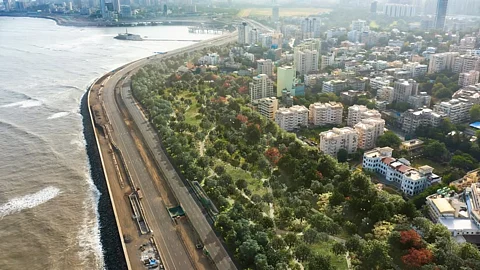
- HOMEGROWN WORLD
- #HGCREATORS
- #HGEXPLORE
- #HGVOICES
- #HGSHOP
- CAREERS
- ABOUT US
- CONTACT US

Imagine walking down Marine Drive one morning, not greeted by fresh sea air, but by a dense haze that clings to your breath with he sun appearing pale and muted through a canopy of smog. More often not this is the reality of Mumbai. In a city known for its vitality, its endless construction, and its race to modernise, the metropolis is also suffocating. Towering skyscrapers are rising faster than old trees fall. Mangroves, once natural protectors of the coast, are vanishing beneath reclamation projects. Concrete replaces soil. Sea walls replace wetlands. And in this slow erosion of natural buffers, the city’s climate is growing harsher — hotter summers, heavier rains, and air laced with particulate matter.
But while the city chokes on its own progress, a bold counter-vision has emerged from the collective imagination of its citizens. The Mumbai Coastal Forest Project is an initiative that's entirely grassroots; cultivated through scientific insight, and public demand. A petition backed by over 60,000 signatories has implored the Prime Minister, the Chief Minister, and the BMC Commissioner to designate the reclaimed coastal land as a public forest, rejecting commercial developments like malls, clubs, or parking lots.
The proposal centers on transforming about 70 hectares of reclaimed land along the western coast of South Mumbai, specifically the stretch between Priyadarshini Park in Napean Sea Road and Worli Sea Face, into a forest. This land, reclaimed as part of the Coastal Road Project, holds immense ecological potential. The vision is not for manicured gardens or decorative promenades, but for a robust ecosystem of native, salt and wind tolerant trees such as peepal, neem, amaltas, and coastal species. Beneath this canopy public life would flourish: walkers, cyclists, children playing, families resting in shade — Mumbaikars reclaiming their right to breathe, literally.
Around the world, cities facing similar ecological and urban pressures have turned to ambitious green infrastructure to improve livability. The tropical forest model resonates with global successes — Tokyo’s urban 'Miyawaki' forests, New York’s Central Park, and Singapore’s 'Garden City' green corridor— demonstrating that when urban planning honors ecological design, cities can heal. The Mumbai Coastal Forest Project draws from this same ethos, offering a local response to a shared global crisis.
Between February and April 2025, Mumbai endured hazardous air quality, with PM₁₀ levels exceeding national norms on more than half the days, and PM₂.₅ hotspots regularly breaching health thresholds. Though monsoon rains briefly lowered particulate levels, Mumbai still lags behind fellow coastal cities like Chennai, Kochi, and Vijayawada, highlighting the urgent need for urban greening year‑round. The Coastal Forest equally responds to the ecological damage inflicted during infrastructure expansion — dust, construction waste, and concrete have clouded the skyline. Projects such as Metro‑11 threaten 2,200 trees, and even concrete plants in Vasai‑Virar have been booked for pollution. Against this backdrop, the Coastal Forest feels fairly essential.
If supported with the right frameworks, the project could truly take root — not just symbolically, but structurally. Integrating it into the Mumbai Climate Action Plan (MCAP) would anchor it within the city’s broader sustainability goals. A citizen–government oversight committee could ensure long-term transparency and accountability. Involving ecologists and landscape architects from the outset would help shape a forest that is ecologically sound, not just visually appealing. And with legal safeguards against future commercial encroachment, this space could be protected for generations. The foundations for success are already visible — what remains is the collective will of the city’s leaders and citizens to act now and make it real.
Follow Mumbai Coastal Project here.
